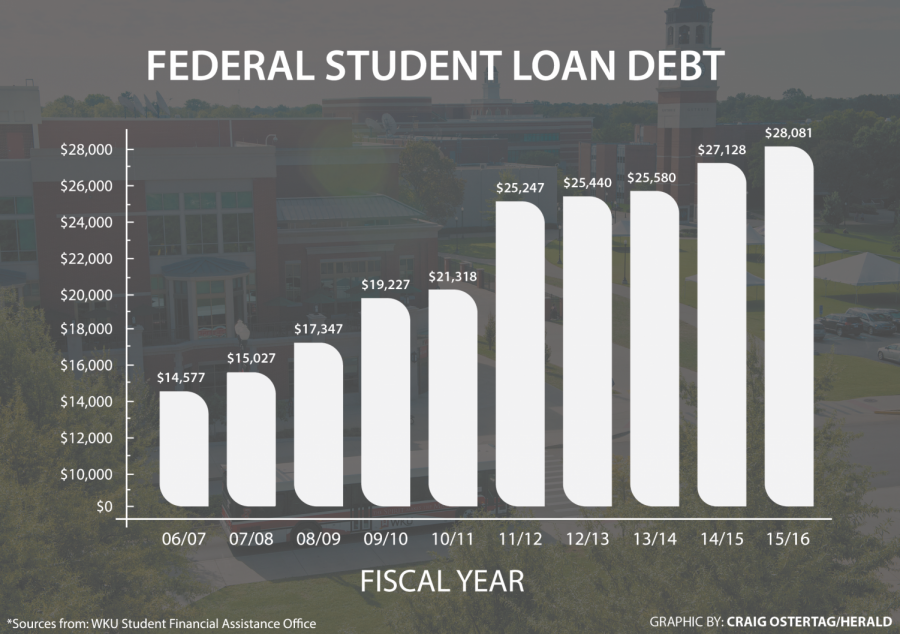WKU students graduate with more loan debt
February 2, 2017
Over the past decade, average debt from federal student loans has nearly doubled for WKU undergraduates.
Cindy Burnette, director of WKU student financial aid assistance, spoke about this increase at the Board of Regents meeting on Jan. 27, presenting information based on the 2015-2016 academic year that showed students are graduating from WKU with more financial debt than before.
“Average loan debts of graduating students have gone up consistently as costs of attending have increased,” Burnette said.
For the 2015-2016 academic year the average WKU student graduated $28,081 in debt from federal loans alone. That average is almost $3,000 more than it was four years ago and over $13,000 more than it was eight years ago. Burnette thinks this increase is due to loan limits.
“Annual loan limits for federal loans have been increased only minimally in the last 15-20 years,” Burnette said in an email. “This has not kept pace with the rising costs of higher education. Students dependent on federal loans to help meet the costs end up with larger gaps that most times must be paid out of pocket (and for many of our students, they do not have the funds to do so).”
Loans make up almost half of the aid given to WKU students. Last year, 18,675 students received over $200 million dollars to help pay for their education. Fifty-two percent of that was in scholarships or grants (which students are not required to pay back) and on-campus employment. The remaining 48 percent rounds out to about $96 million for students to repay according to Burnette’s presentation.
Burnette said WKU has experienced a steady increase in state College Access Program grants. The state awards CAP Grants on a first-come, first-serve basis until the grant funds run out; the earlier students complete their FAFSA, the Free Application for Federal Student Aid, the better odds they have of receiving a CAP.
However last year only about 12,500 WKU undergraduate students filled out the application, but over 30 percent of WKU students qualify for need-based grants. To fill out a FAFSA, students can visit www.fafsa.gov.
The increase of debt may partially be due to the decrease in WKU students receiving federal Pell Grants. Almost 8,000 students received federal Pell Grants during the 2012-2013 academic year, while about 6,300 received them last year. Those Pell Grants range anywhere from $591 to $5,815 for the year.
With this decline in Pell Grants, several students have expressed concern with the lack of recent higher education funding.
Morgan Howe, a Bowling Green non-traditional junior originally from New York, said recent cuts were influencing his aid.
“I think federal aid is extremely important,” Howe said. “Many students depend on it for their education. When grants get cut, people can’t recover.”
Some students are attending a rally in Frankfort for higher education later this month, including SGA President and Board of Regents member Jay Todd Richey.
The rally is Feb 13 from 1-3 p.m. in the Kentucky State Capitol Rotunda. Richey said all Kentucky public university students have been invited to attend.
“The purpose of the rally is to show legislators and the governor that we care about higher education and that it’s unacceptable to face cuts every year,” he said.
Burnette added that it is important students remain aware of the cost of attendance as well as the resources available to help meet the costs.
“The reality is that in many instances, there is not enough federal, state or institutional aid available to cover total costs and families have to be prepared to pay any shortfall,” she said.
Reporter Bryson Keltner can be reached at 270-745-6011 and [email protected].




















![Students cheer for Senator at Large Jaden Marshall after being announced as the Intercultural Student Engagement Center Senator for the 24th Senate on Wednesday, April 17 in the Senate Chamber in DSU. Ive done everything in my power, Ive said it 100 times, to be for the students, Marshall said. So, not only to win, but to hear that reaction for me by the other students is just something that shows people actually care about me [and] really support me.](https://wkuherald.com/wp-content/uploads/2024/04/jadenmarshall-600x422.jpg)





